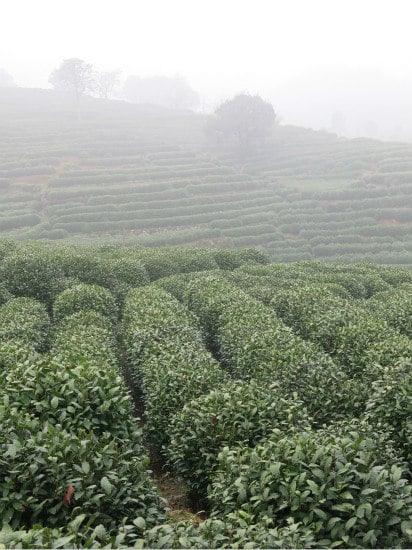Association between Empirically Estimated Monsoon Dynamics and Other Weather Factors and Historical Tea Yields in China: Results from a Yield Response Model
Abstract
:1. Introduction
2. Experimental Section
2.1. Data Sources
2.2. Methods and Statistical Analysis
2.2.1. Monsoon Onset and Retreat Estimation and Weather Variable Construction
2.2.2. Regression Methods
3. Results and Discussion
3.1. Trends in Yield, Weather Factors, and Monsoon Dynamics over China’s Tea Growing Regions
3.2. Regression Results
4. Discussion
5. Conclusions and Limitations
Supplementary Files
Supplementary File 1Supplementary File 2Acknowledgments
Author Contributions
Conflicts of Interest
References
- Chen, L.; Zhou, Z. Variations of main quality components of tea genetic resources [Camellia Sinensis (L.) O. Kuntze] preserved in the China National Germplasm Tea Repository. Plant. Foods Hum. Nutr. 2005, 60, 31–35. [Google Scholar] [CrossRef] [PubMed]
- Food and Agriculture Organization. FAOSTAT. Available online: http://faostat.fao.org/ (accessed on 28 April 2014).
- Owuor, P.O.; Wachira, F.N.; Ng’etich, W.K. Influence of region of production on relative clonal plain tea quality parameters in Kenya. Food Chem. 2010, 119. [Google Scholar] [CrossRef]
- Columbia Law School Human Rights Institute. “The More Things Change...” The World Bank, Tata and Enduring Abuses on India’s Tea Plantations. Columbia Law School Human Rights Institute. Available online: http://web.law.columbia.edu/sites/default/files/microsites/human-rights-institute/files/tea_report_final_draft-smallpdf.pdf (accessed on 26 January 2015).
- Han, W. Climate Change and its Impacts on Tea Economy and Counteract Strategies in China; Intergovernmental Group on Tea of the Food and Agricultural Organization of the United Nations: Colombo, Sri Lanka, 2012. [Google Scholar]
- Bukowski, J.F.; Percival, S.S. L-Theanine intervention enhances human γδ T lymphocyte function. Nutr. Rev. 2008, 66, 96–102. [Google Scholar] [CrossRef] [PubMed]
- Da Silva Pinto, M. Tea: A New Perspective on health benefits. Food Res. Int. 2013, 53, 558–567. [Google Scholar] [CrossRef]
- Wang, L.; Zhang, X.; Liu, J.; Shen, L.; Li, Z. Tea consumption and lung cancer risk: A meta-analysis of case-control and cohort studies. Nutrition 2014, 30, 1122–1127. [Google Scholar] [CrossRef] [PubMed]
- Arab, L.; Khan, F.; Lam, H. Tea Consumption and cardiovascular disease risk. Am. J. Clin. Nutr. 2013, 98, 1651S–1659S. [Google Scholar] [CrossRef] [PubMed]
- Blumberg, J.B. Introduction to the proceedings of the fifth international scientific symposium on tea and human health. Am. J. Clin. Nutr. 2013, 98, 1607S–1610S. [Google Scholar] [CrossRef] [PubMed]
- Chaturvedula, V.S.P.; Prakash, I. The aroma, taste, color and bioactive constituents of tea. J. Med. Plants Res. 2011, 5, 2110–2124. [Google Scholar]
- McKay, D.L.; Blumberg, J.B. The role of tea in human health: An update. J. Am. Coll. Nutr. 2002, 21, 1–13. [Google Scholar] [CrossRef] [PubMed]
- Lin, Y.; Tsai, Y.; Tsay, J.; Lin, J. Factors affecting the levels of tea polyphenols and caffeine in tea leaves. J. Agric. Food Chem. 2003, 51, 1864–1873. [Google Scholar] [CrossRef] [PubMed]
- Kowalsick, A.; Kfoury, N.; Robbat, A., Jr.; Ahmed, S.; Orians, C.; Griffin, T.; Cash, S.B.; Stepp, J.R. Metabolite profiling of Camellia Sinensis by automated sequential, multidimensional gas chromatography/mass spectrometry reveals strong monsoon effects on tea constituents. J. Chromatogr. A 2014, 1370, 230–239. [Google Scholar] [CrossRef] [PubMed]
- Hönow, R.; Gu, K.R.; Hesse, A.; Siener, R. Oxalate content of green tea of different origin, quality, preparation and time of harvest. Urol. Res. 2010, 38, 377–381. [Google Scholar] [CrossRef] [PubMed]
- Yao, L.; Caffin, N.; D’arcy, B.; Jiang, Y.; Shi, J.; Singanusong, R.; Liu, X.; Datta, N.; Kakuda, Y.; Xu, Y. Seasonal variations of phenolic compounds in Australia-grown tea (Camellia Sinensis). J. Agric. Food Chem. 2005, 53, 6477–6483. [Google Scholar] [CrossRef] [PubMed]
- Gulati, A.; Ravindranath, S.D. Seasonal variations in quality of Kangra Tea (Camellia sinensis(L) O Kuntze) in Himachal Pradesh. J. Sci. Food Agric. 1996, 71, 231–236. [Google Scholar] [CrossRef]
- Ahmed, S.; Stepp, J.R.; Orians, C.; Griffin, T.; Matyas, C.; Robbat, A.; Cash, S.; Xue, D.; Long, C.; Unachukwu, U.; et al. Effects of extreme climate events on tea (Camellia Sinensis) functional quality validate indigenous farmer knowledge and sensory preferences in tropical China. PLoS ONE 2014, 9, e109126. [Google Scholar] [CrossRef] [PubMed]
- Ahmed, S.; Orians, C.M.; Griffin, T.S.; Buckley, S.; Unachukwu, U.; Stratton, A.E.; Stepp, J.R.; Robbat, A.; Cash, S.; Kennelly, E. Effects of water availability and pest pressures on tea (Camellia Sinensis) growth and functional quality. AoB Plants 2014. [Google Scholar] [CrossRef] [PubMed]
- Wang, J.; Huang, J.; Rozelle, S. 2010. Climate Change and China’s Agricultural Sector: An Overview of Impacts, Adaptation and Mitigation. ICTSD-IPC Platform on Climate Change, Agriculture and Trade. Issue Brief No. 5. Geneva, Switzerland: International Centre for Trade and Sustainable Development and International Food and Agriculutral Trade Policy Council. Available online: http://www.ictsd.org/downloads/2010/06/climate-change-and-chinas-agricultural-sector.pdf (accessed on 10 June 2012).
- Wang, H.; Sun, J.; Chen, H.; Zhu, Y.; Zhang, Y.; Jiang, D.; Lang, X.; Fan, K.; Yu, E.; Yang, S. Extreme climate in China: Facts, simulation and projection. Meteorol. Z. 2012, 21, 279–304. [Google Scholar] [CrossRef]
- Wild, M.; Gilgen, H.; Roesch, A.; Ohmura, A.; Long, C.N.; Dutton, E.G.; Forgan, B.; Kallis, A.; Russak, V.; Tsvetkov, A. From dimming to brightening: Decadal changes in solar radiation at Earth’s surface. Science 2005, 308, 847–850. [Google Scholar] [CrossRef] [PubMed]
- Tao, F.; Yokozawa, M.; Xu, Y.; Hayashi, Y.; Zhang, Z. Climate changes and trends in phenology and yields of field crops in China, 1981–2000. Agric. For. Meteorol. 2006, 138, 82–92. [Google Scholar] [CrossRef]
- Lou, W.; Sun, S. Design of agricultural insurance policy for tea tree freezing damage in Zhejiang Province, China. Theor. Appl. Climatol. 2013, 111, 713–728. [Google Scholar] [CrossRef]
- IPCC. Summary for Policymakers: The Physical Science Basis; Cambridge University Press: Cambridge, UK, 2014. [Google Scholar]
- Lang, X.; Sui, Y. Changes in mean and extreme climates over China with a 2 C global Warming. Chin. Sci. Bull. 2013, 58, 1453–1461. [Google Scholar] [CrossRef]
- IPCC. Summary for Policymakers: Impacts, Adaptation, and Vulnerability. Climate Change 2014: Impacts, Adaptation, and Vulnerability. Part A: Global and Sectoral Aspects. Available online: http://www.ipcc.ch/pdf/assessment-report/ar5/wg2/ar5_wgII_spm_en.pdf (accessed on 1 June 2012).
- Carr, M.K.V. The climatic requirements of the tea plant: A review. Exp. Agric. 1972, 8, 1–14. [Google Scholar] [CrossRef]
- Auffhammer, M.; Ramanathan, V.; Vincent, J.R. Climate change, the monsoon, and rice yield in India. Clim. Chang. 2012, 111, 411–424. [Google Scholar] [CrossRef]
- Deschênes, O.; Kolstad, C. Economic impacts of climate change on California agriculture. Clim. Chang. 2011, 109, 365–386. [Google Scholar] [CrossRef]
- Deschênes, O.; Greenstone, M. The economic impacts of climate change: Evidence from agricultural output and random fluctuations in weather. Am. Econ. Rev. 2007, 97, 354–385. [Google Scholar] [CrossRef]
- Lobell, D.B.; Schlenker, W.; Costa-Roberts, J. Climate trends and global crop production since 1980. Science 2011, 333, 616–620. [Google Scholar] [CrossRef] [PubMed]
- Shi, W.; Tao, F.; Zhang, Z. A review on statistical models for identifying climate contributions to crop yields. J. Geogr. Sci. 2013, 23, 567–576. [Google Scholar] [CrossRef]
- Dodd, D.E.S.; Jolliffe, I.T. Early detection of the start of the wet season in semiarid tropical climates of Western Africa. Int. J. Climatol. 2001, 21, 1251–1262. [Google Scholar] [CrossRef]
- Laux, P.; Kunstmann, H.; Bárdossy, A. Predicting the regional onset of the rainy season in West Africa. Int. J. Climatol. 2008, 28, 329–342. [Google Scholar] [CrossRef]
- Muggeo, V.M.R. Estimating regression models with unknown break-points. Stat. Med. 2003, 22, 3055–3071. [Google Scholar] [CrossRef] [PubMed]
- Cook, B.I.; Buckley, B.M. Objective determination of monsoon season onset, withdrawal, and length. J. Geophys. Res. Atmos. 2009, 114, D23109. [Google Scholar] [CrossRef]
- Huang, S. Meteorology of the tea plant in China: A review. Agric. For. Meteorol. 1989, 47, 19–30. [Google Scholar] [CrossRef]
- Lou, W.; Sun, S.; Wu, L.; Sun, K. Effects of climate change on the economic output of the Longjing-43 tea tree, 1972–2013. Int. J. Biometeorol. 2014. [Google Scholar] [CrossRef] [PubMed]
- Lou, W.; Sun, K.; Sun, S.; Ma, F.; Wang, D. Changes in pick beginning date and frost damage risk of tea tree in Longjing tea-producing area. Theor. Appl. Climatol. 2013, 114, 115–123. [Google Scholar] [CrossRef]
- Lou, W.; Ji, Z.; Sun, K.; Zhou, J. Application of remote sensing and GIS for assessing economic loss caused by frost damage to tea plantations. Precis. Agric. 2013, 14, 606–620. [Google Scholar] [CrossRef]
- Yang, Y. Chinese Tea Cultivation; Shanghai Scientific & Technical Publishers: Shanghai, China, 2005. [Google Scholar]
- Laycock, D.H. An Empirical Relationship between Rainfall and Tea Yields in Nyasaland; Special Meeting of Applied Meteorology: Nairobi, Kenya, 1958. [Google Scholar]
- Reyer, C.P.O.; Leuzinger, S.; Rammig, A.; Wolf, A.; Bartholomeus, R.P.; Bonfante, A.; de Lorenzi, F.; Dury, M.; Gloning, P.; Abou Jaoudé, R.; et al. A plant’s perspective of extremes: Terrestrial plant responses to changing climatic variability. Glob. Chang. Biol. 2013, 19, 75–89. [Google Scholar] [CrossRef] [PubMed]
- Monteith, J.L. Solar radiation and productivity in tropical ecosystems. J. Appl. Ecol. 1972, 9, 747–766. [Google Scholar] [CrossRef]
- Rienecker, M.M.; Suarez, M.J.; Gelaro, R.; Todling, R.; Bacmeister, J.; Liu, E.; Bosilovich, M.G.; Schubert, S.D.; Takacs, L.; Kim, G. MERRA: NASA’s Modern-Era retrospective analysis for research and applications. J. Clim. 2011, 24, 3624–3648. [Google Scholar] [CrossRef]
- Ensor, L.A.; Robeson, S.M. Statistical characteristics of daily precipitation: Comparisons of gridded and point datasets. J. Appl. Meteorol. Climatol. 2008, 47, 2468–2476. [Google Scholar] [CrossRef]
- Decker, M.; Brunke, M.A.; Wang, Z.; Sakaguchi, K.; Zeng, X.; Bosilovich, M.G. Evaluation of the reanalysis products from GSFC, NCEP, and ECMWF using flux tower observations. J. Clim. 2012, 25, 1916–1944. [Google Scholar] [CrossRef]
- Yuan, W.; Xu, B.; Chen, Z.; Xia, J.; Xu, W.; Chen, Y.; Wu, X.; Fu, Y. Validation of China-wide interpolated daily climate variables from 1960 to 2011. Theor. Appl. Climatol. 2015, 119, 689–700. [Google Scholar] [CrossRef]
- Wang, A.; Zeng, X. Evaluation of multireanalysis products with in situ observations over the Tibetan Plateau. J. Geophys. Res. Atmos. 2012. [Google Scholar] [CrossRef]
- Ruane, A.C.; Goldberg, R.; Chryssanthacopoulos, J. Climate forcing datasets for agricultural modeling: Merged products for gap-filling and historical climate series estimation. Agric. For. Meteorol. 2015, 200, 233–248. [Google Scholar] [CrossRef]
- National Bureau of Statistics of China. China Statistical Yearbook (1979–2011); China Statistics Press: Beijing, China, 2011. [Google Scholar]
- Han, W.; (Tea Research Institute, Chinese Academy of Agricultural Sciences, Hangzhou City, China). Personal communication, 2015.
- Esri, ArcGIS Desktop. Available online: http://www.esri.com/software/arcgis/arcgis-for-desktop (accessed on 12 September 2012).
- R Core Team. R: A language and environment for statistical Computing; R Foundation for Statistical Computing: Vienna, Austria, 2011. [Google Scholar]
- Zhai, P.; Zhang, X.; Wan, H.; Pan, X. Trends in total precipitation and frequency of daily precipitation extremes over China. J. Climate 2005, 18, 1096–1108. [Google Scholar] [CrossRef]
- Auffhammer, M.; Ramanathan, V.; Vincent, J.R. Integrated model shows that atmospheric brown clouds and greenhouse gases have reduced rice harvests in India. Proc. Natl. Acad. Sci. USA 2006, 103, 19668–19672. [Google Scholar] [CrossRef] [PubMed]
- Wooldridge, J. Introductory Econometrics: A Modern Approach; Cengage Learning: Mason, OH, USA, 2012. [Google Scholar]
- Greene, W.H. Econometric Analysis; Prentice Hall: Boston, MA, USA, 2011. [Google Scholar]
- Clark, D.A.; Clark, D.B. Climate-induced annual variation in canopy tree growth in a Costa Rican tropical rain forest. J. Ecol. 1994, 82. [Google Scholar] [CrossRef]
- Franzluebbers, A.J. Water infiltration and soil structure related to organic matter and its stratification with depth. Soil Tillage Res. 2002, 66, 197–205. [Google Scholar] [CrossRef]
- Auffhammer, M.; Hsiang, S.M.; Schlenker, W.; Sobel, A. Using Weather Data and Climate Model Output in Economic Analyses of Climate Change. Rev. Environ. Econ. Policy 2013, 7, 181–198. [Google Scholar] [CrossRef]
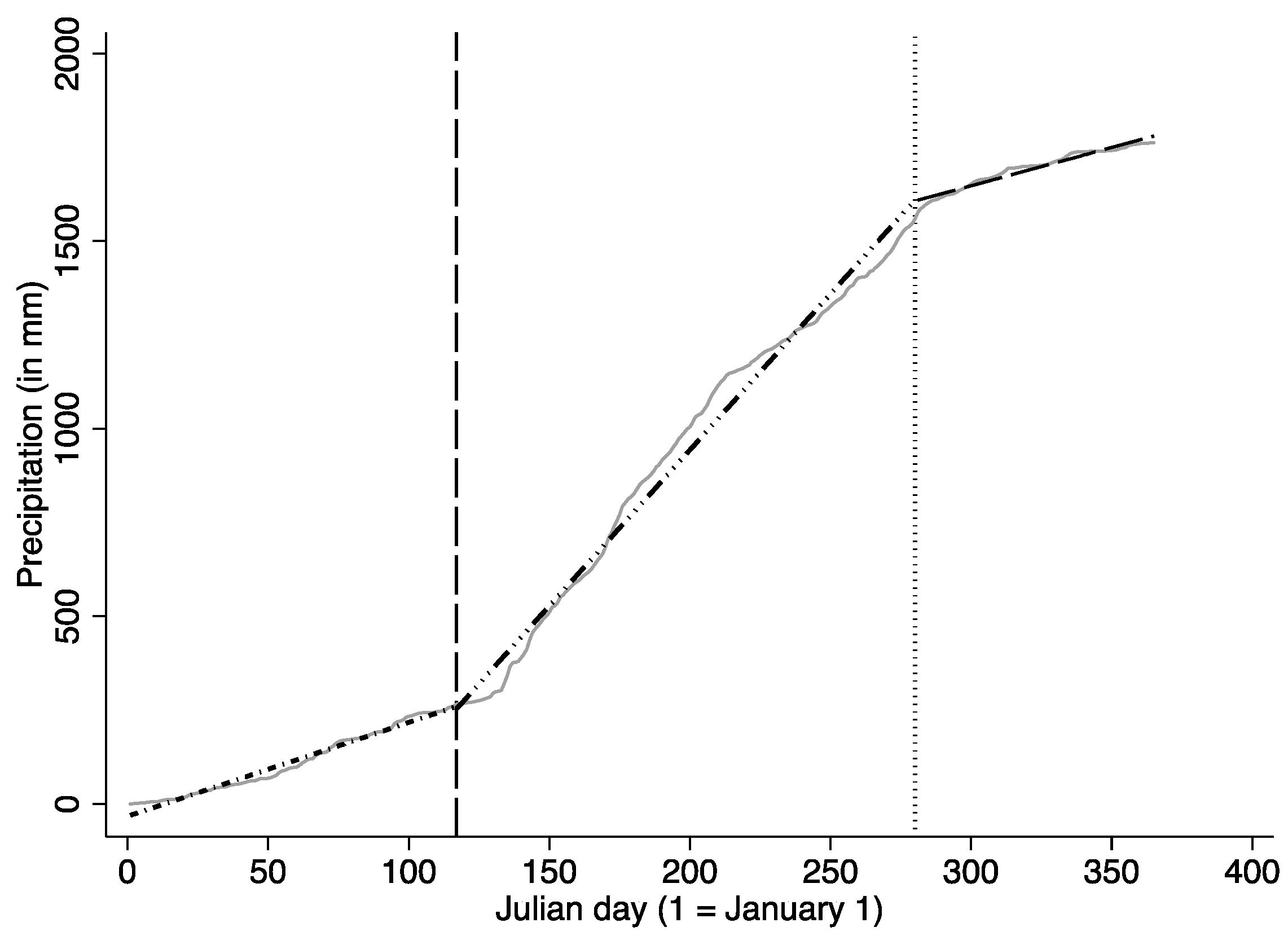
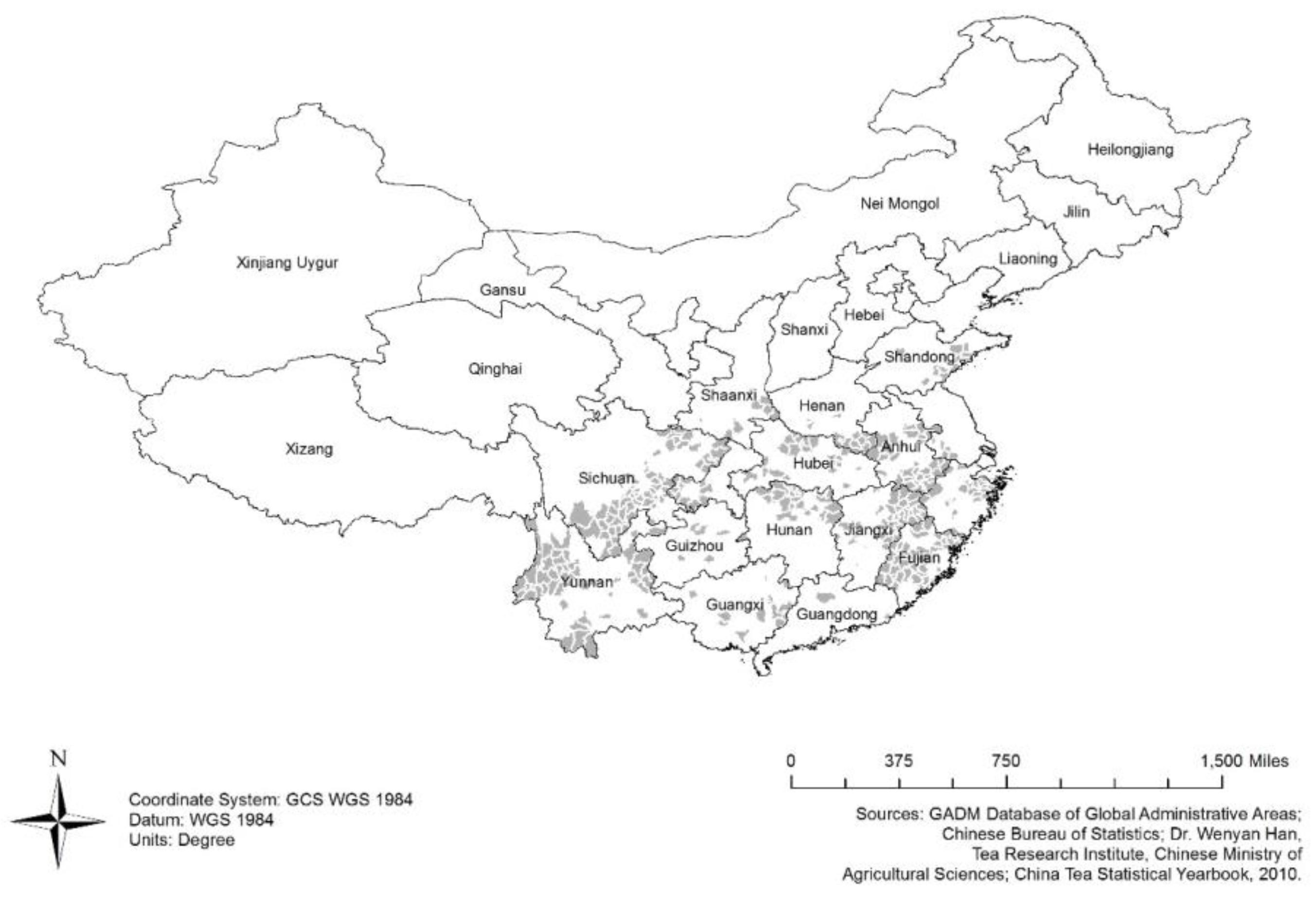
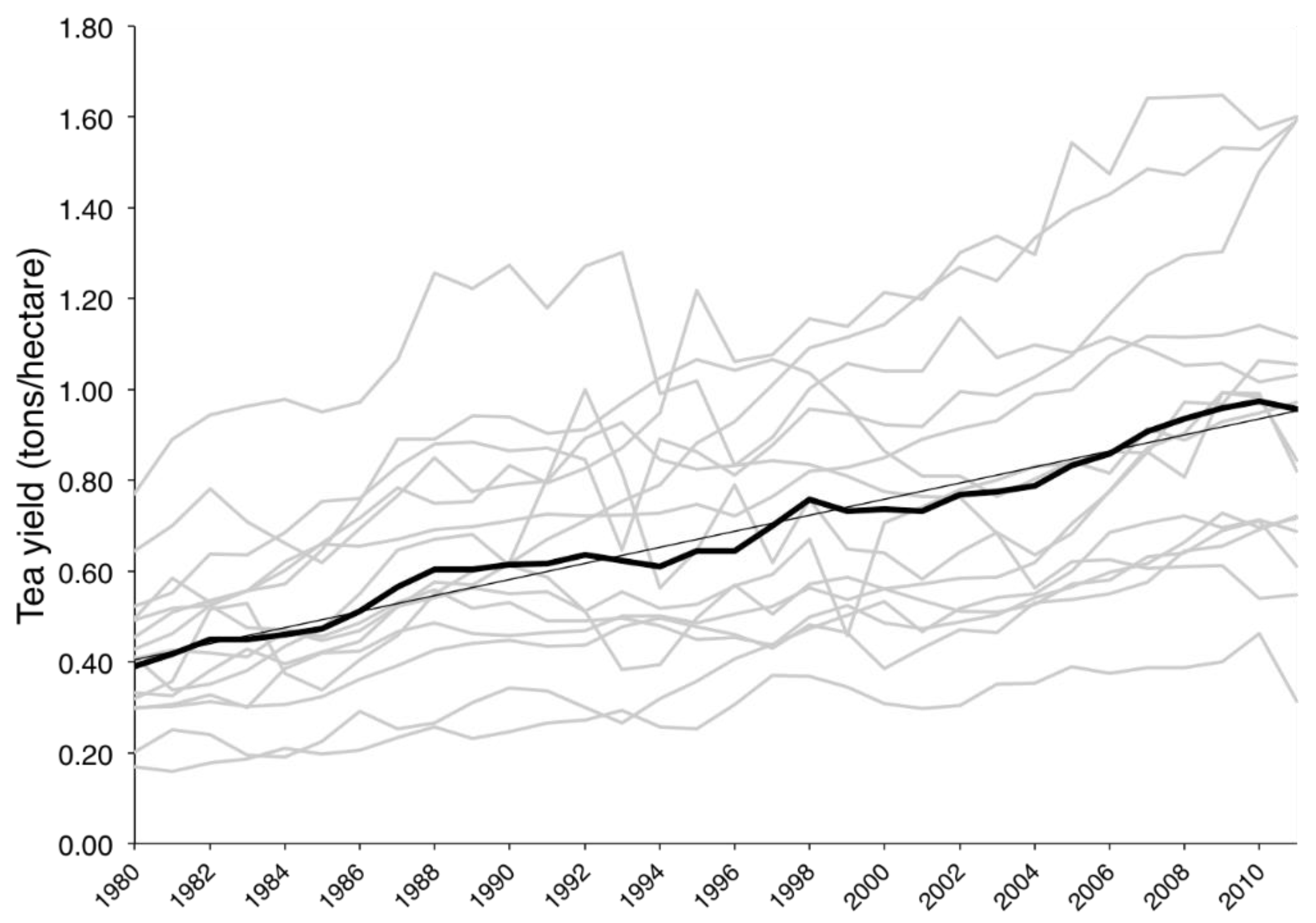
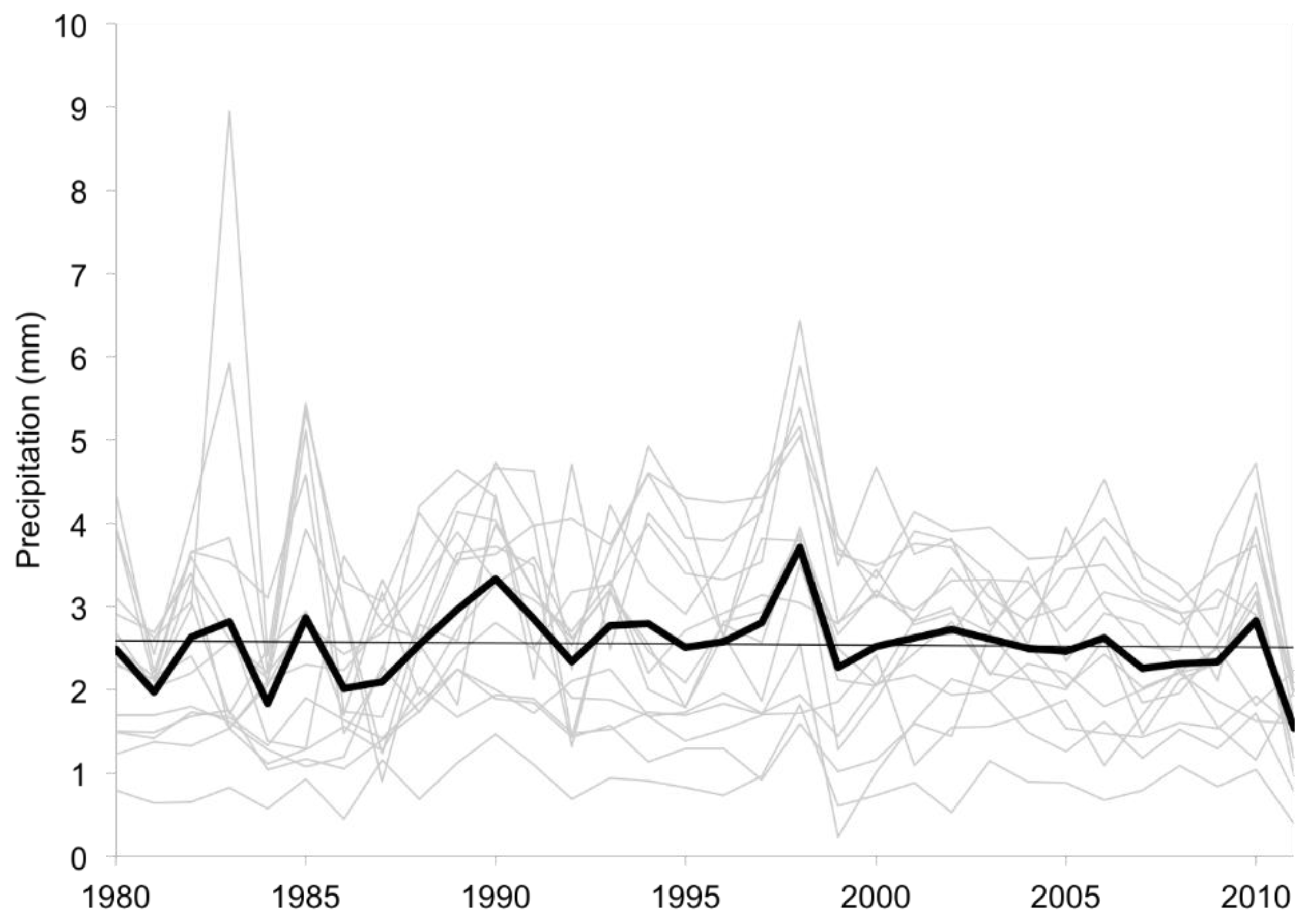

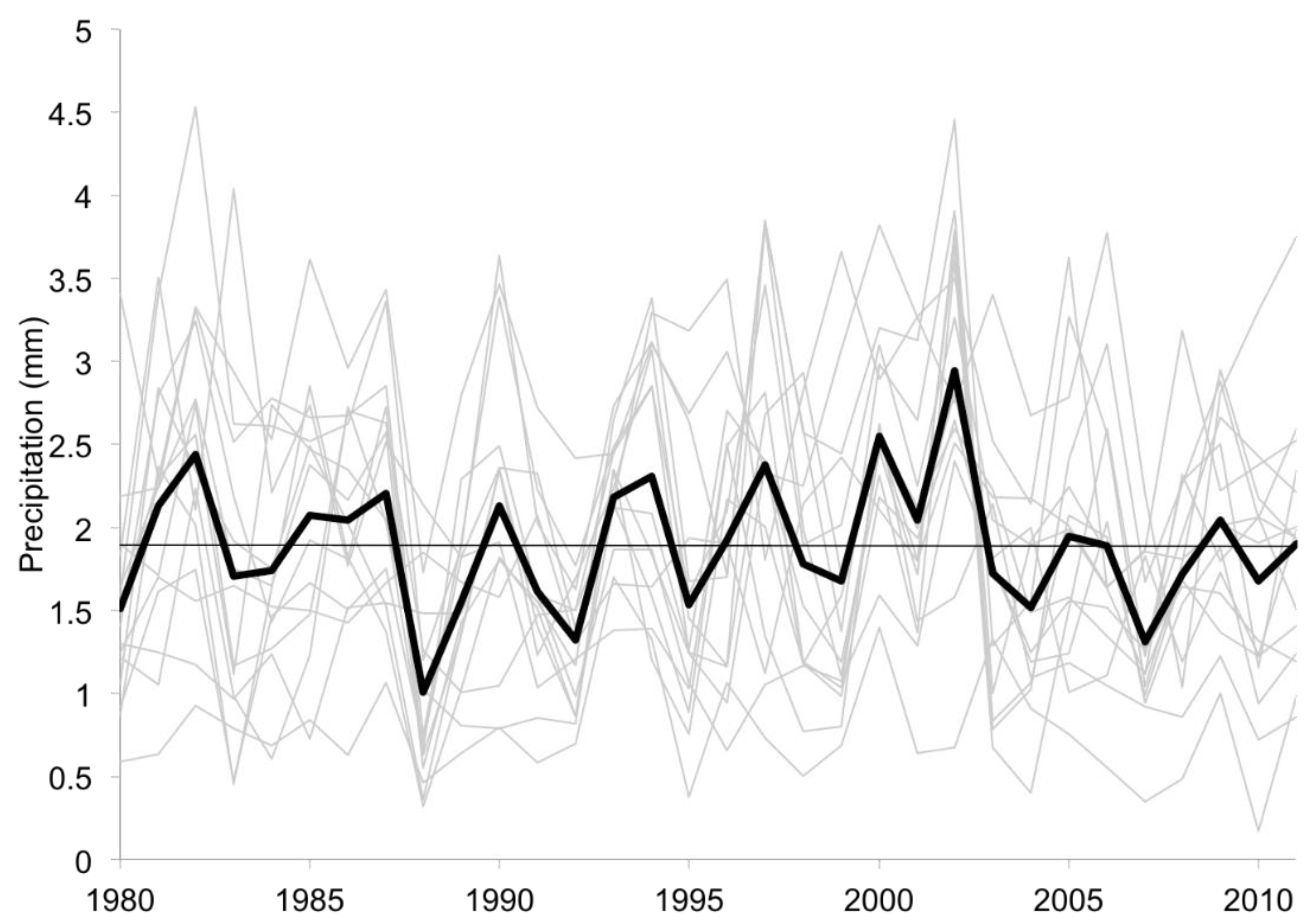
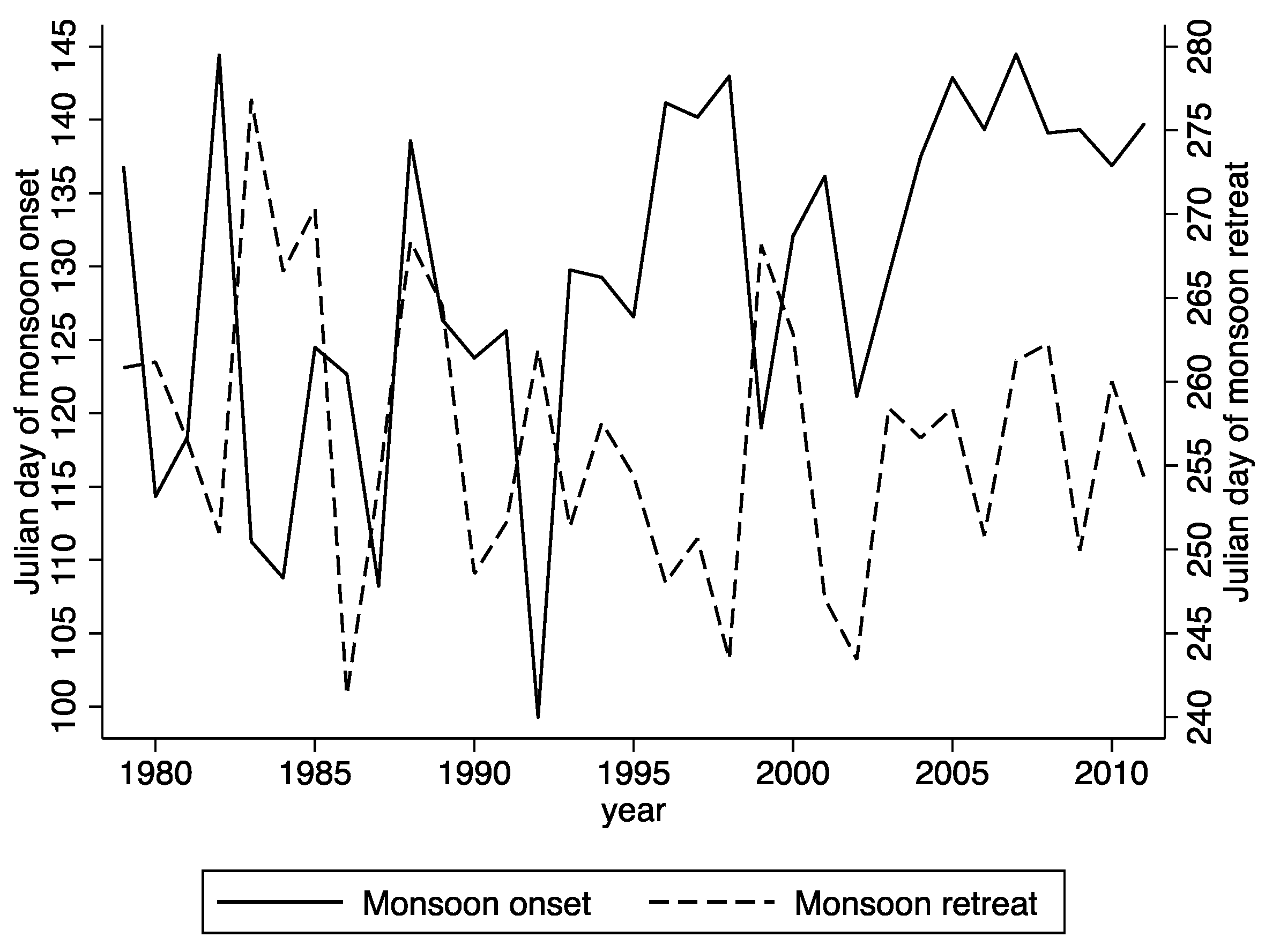
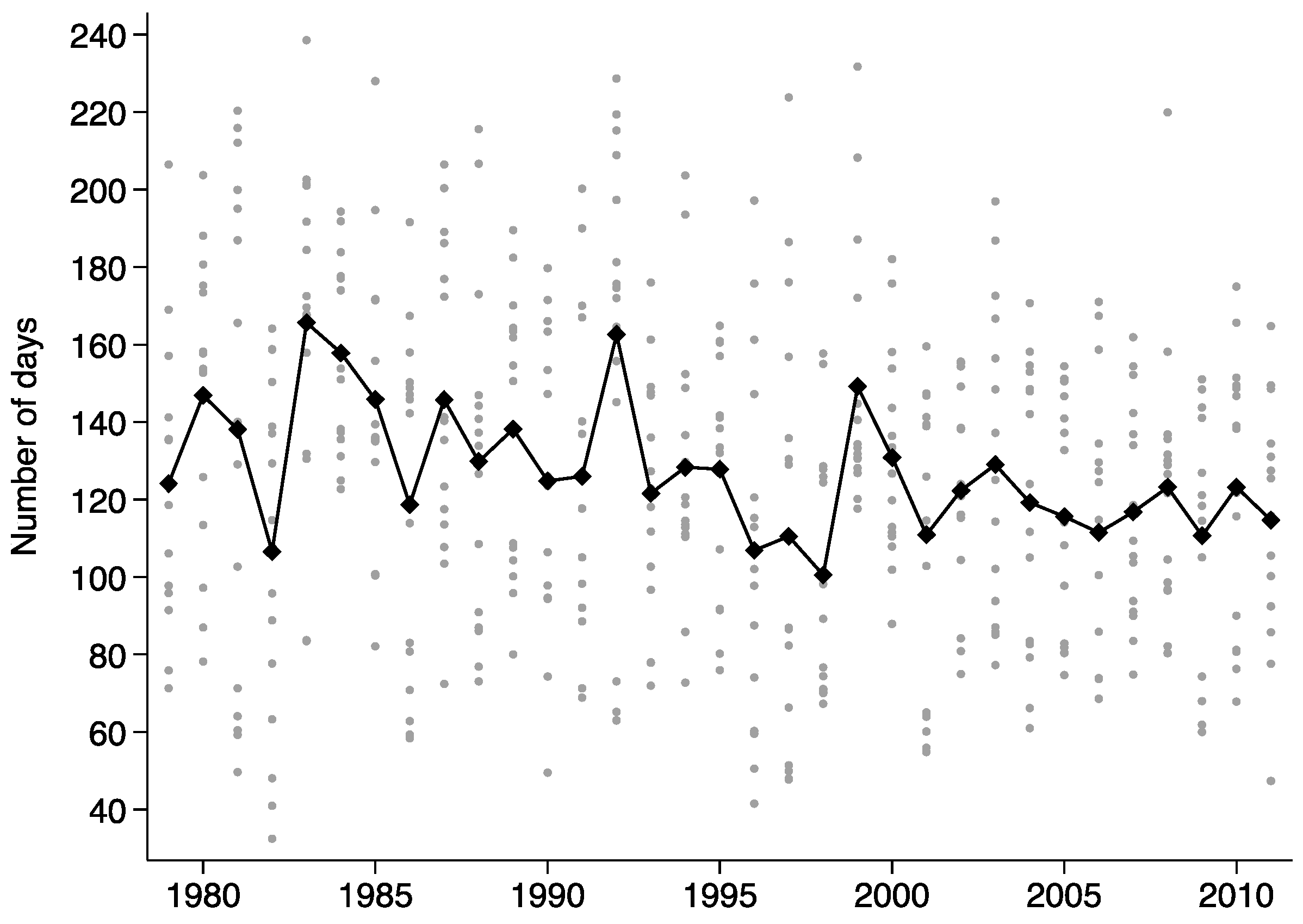
| Variable | Description of Construction |
|---|---|
| Monsoon duration (days) |
|
| Monsoon onset/retreat date (Julian day) | Estimated date upon which the monsoon onset/retreat occurs. |
| Pre-monsoon rainfall (mm) | Averaged daily gridded precipitation data across grid cells within the tea-growing region of each province. Then the average total daily rainfall during the approximated pre-monsoon period (1 January—monsoon onset date) was obtained. |
| Monsoon rainfall (mm) | Averaged daily gridded precipitation data across grid cells within the tea-growing region of each province. Then average total daily rainfall during the approximated monsoon period (monsoon onset date—monsoon retreat date) was obtained. |
| Post-monsoon rainfall (mm) | Averaged daily gridded precipitation data across grid cells within the tea-growing region of a province. Then average total daily rainfall occurring during the approximated post-monsoon period (monsoon retreat date—31 December) was obtained. |
| Pre-monsoon minimum temperature (°C) |
|
| Monsoon minimum temperature (°C) |
|
| Pre-monsoon surface radiation (W/m2) |
|
| Monsoon surface radiation (W/m2) |
|
| 1980 | 1985 | 1990 | 1995 | 2000 | 2005 | 2010 | |
|---|---|---|---|---|---|---|---|
| Mean monsoon onset | 114.3 | 124.5 | 123.8 | 126.6 | 132.1 | 142.9 | 136.9 |
| SD monsoon onset | 34.8 | 35.3 | 24.5 | 33.5 | 24.7 | 30.4 | 30.9 |
| Mean monsoon retreat | 261.2 | 270.3 | 248.5 | 254.4 | 262.9 | 258.4 | 260.0 |
| SD monsoon retreat | 15.5 | 14.4 | 26.3 | 16.2 | 14.7 | 16.3 | 12.3 |
| Mean monsoon duration | 146.8 | 145.8 | 124.8 | 127.8 | 130.8 | 115.6 | 123.2 |
| SD monsoon duration | 38.1 | 37.9 | 38.6 | 30.6 | 27.5 | 30.6 | 35.5 |
| All Variables are in Logarithmic form Standard Errors in Parentheses | 1 | 2 | 3 | 4 |
|---|---|---|---|---|
| Monsoon onset (Julian days) | 0.051 | 0.033 | ||
| (0.127) | (0.128) | |||
| Monsoon retreat (Julian days) | −0.481 ** | −0.535 ** | ||
| (0.244) | (0.248) | |||
| Monsoon duration | −0.096 | −0.100 | ||
| (0.078) | (0.085) | |||
| Pre-monsoon average daily T-min (°C) | −0.019 | −0.025 | −0.018 | −0.018 |
| (0.024) | (0.024) | (0.024) | (0.025) | |
| Monsoon average daily T-min (°C) | 0.131 | 0.331 | 0.087 | 0.153 |
| (0.384) | (0.406) | (0.314) | (0.331) | |
| Pre-monsoon average daily precipitation (mm) | 0.087 | 0.087 | 0.083 | 0.082 |
| (0.069) | (0.070) | (0.061) | (0.064) | |
| Monsoon average daily precipitation (mm) | −0.228 ** | −0.262 ** | −0.169 | −0.184 * |
| (0.112) | (0.113) | (0.110) | (0.112) | |
| Post-monsoon period average daily precipitation (mm) | −0.031 | −0.043 | −0.016 | −0.020 |
| (0.030) | (0.031) | (0.029) | (0.030) | |
| Pre-monsoon average daily solar radiation (W/m2) | −0.046 | −0.073 | −0.098 | −0.103 |
| (0.287) | (0.292) | (0.252) | (0.264) | |
| Monsoon average daily solar radiation (W/m2) | −0.472 | −0.481 | −0.247 | −0.237 |
| (0.331) | (0.341) | (0.312) | (0.327) | |
| Time trend | 0.025 *** | 0.025 *** | 0.025 *** | 0.025 *** |
| (0.001) | (0.001) | (0.001) | (0.001) | |
| ONE-YEAR LAG VARIABLES | ||||
| Pre-monsoon average daily T-min (°C) | −0.030 | −0.029 | ||
| (0.031) | (0.032) | |||
| Monsoon average daily T-min (°C) | 0.127 | 0.050 | ||
| (0.372) | (0.311) | |||
| Pre-monsoon average daily precipitation (mm) | 0.051 | 0.063 | ||
| (0.065) | (0.059) | |||
| Monsoon average daily precipitation (mm) | −0.327 *** | −0.258 ** | ||
| (0.122) | (0.120) | |||
| Post-monsoon average daily precipitation (mm) | −0.035 | −0.012 | ||
| (0.031) | (0.029) | |||
| Pre-monsoon average daily surface radiation (W/m2) | 0.040 | −0.031 | ||
| (0.274) | (0.265) | |||
| Monsoon average daily surface radiation (W/m2) | −0.864 ** | −0.554 * | ||
| (0.337) | (0.306) | |||
| Monsoon onset (Julian days) | 0.075 | |||
| (0.116) | ||||
| Monsoon retreat (Julian days) | −0.604 ** | |||
| (0.248) | ||||
| Monsoon duration | −0.131 | |||
| (0.085) | ||||
| Number of observations | 462 | 451 | 462 | 451 |
© 2016 by the authors; licensee MDPI, Basel, Switzerland. This article is an open access article distributed under the terms and conditions of the Creative Commons by Attribution (CC-BY) license (http://creativecommons.org/licenses/by/4.0/).
Share and Cite
Boehm, R.; Cash, S.B.; Anderson, B.T.; Ahmed, S.; Griffin, T.S.; Robbat, A.; Stepp, J.R.; Han, W.; Hazel, M.; Orians, C.M. Association between Empirically Estimated Monsoon Dynamics and Other Weather Factors and Historical Tea Yields in China: Results from a Yield Response Model. Climate 2016, 4, 20. https://doi.org/10.3390/cli4020020
Boehm R, Cash SB, Anderson BT, Ahmed S, Griffin TS, Robbat A, Stepp JR, Han W, Hazel M, Orians CM. Association between Empirically Estimated Monsoon Dynamics and Other Weather Factors and Historical Tea Yields in China: Results from a Yield Response Model. Climate. 2016; 4(2):20. https://doi.org/10.3390/cli4020020
Chicago/Turabian StyleBoehm, Rebecca, Sean B. Cash, Bruce T. Anderson, Selena Ahmed, Timothy S. Griffin, Albert Robbat, John Richard Stepp, Wenyan Han, Matt Hazel, and Colin M. Orians. 2016. "Association between Empirically Estimated Monsoon Dynamics and Other Weather Factors and Historical Tea Yields in China: Results from a Yield Response Model" Climate 4, no. 2: 20. https://doi.org/10.3390/cli4020020
APA StyleBoehm, R., Cash, S. B., Anderson, B. T., Ahmed, S., Griffin, T. S., Robbat, A., Stepp, J. R., Han, W., Hazel, M., & Orians, C. M. (2016). Association between Empirically Estimated Monsoon Dynamics and Other Weather Factors and Historical Tea Yields in China: Results from a Yield Response Model. Climate, 4(2), 20. https://doi.org/10.3390/cli4020020







